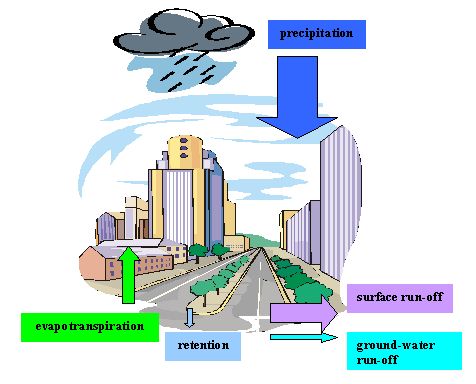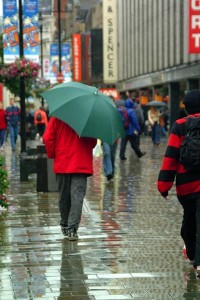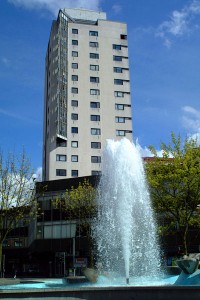|
|
 |
|
|
|
 |
| |
|
|
 |
Urban Climate
Read more |
Water balance in a city
In the urban areas, the sums of precipitation are higher than in non-urban areas, mainly due to short but intensive rainfalls. In a city, asphalt, concrete and stone surfaces prevail. What happens to the water falling down with the precipitation as it cannot infiltrate? |
|
|
|
|
 |
|
For natural areas, the water balance can be defined with the following formula:
P = E +R + S
where:
P - precipitation, the only source of water delivered to the ecosystem
E - evapotranspiration, which means evaporation of the water from the ground combined with transpiration of plants
R - run-off, i.e. the water that leaves the area; it can be divided into surface run-off (i.e. water that flows on the ground surface e.g. to the river), and ground-water run-off (i.e. water that infiltrates to the ground and then flows in the rocks e.g. to the underground water reservoirs, springs or also to the rivers)
S - groundwater storage (retention); note that a snow cover is also a form of temporary water retention
|
 |
 |
|
1. Elements of water balance in a non-urban area
Author: Sebastian Wypych
|
|
In a city (urban areas), the water balance consists of the same elements, but their proportions are significantly different.
Precipitation is usually higher than in non-urban areas, evapotranspiration is much lower, surface run-off is much larger (the ground-water run-off is very little), and the storage is much lower. The changes are illustrated in Figure 2 and explained in the text below it. Please note that the thickness of the arrows marks the differences in comparison to Figure 1.
|
 |
 |
|
2. Changes in water cycle in a city. Compare the thickness of the arrows with Figure 1 to see the differences!
Author: Sebastian Wypych
|
Generally, the effect of a city on air humidity, precipitation and fog formation is the subject of uncertainty. For some cities, increased number of days with fog and higher frequency of cumulus and cumulonimbus clouds were observed. Those phenomena were favoured by both higher air humidity and the presence of large amount of air pollution serving as condensation nuclei. Additionally, clouds formation was enhanced by convenction intensified by urban heat island, and fog formation - by low wind speed or lack of wind. However, every city is located in a certain landform, latitude, distance from the sea etc., and those local conditions may modify the properties of its climate. Additionally, the presence of huge factories or power plants may favour some processes, e.g. deliver air pollution, anthropogenic heat or huge amounts of water vapour from the cooling towers of power plants.
|
 |
 |
 |
|
3. Rain in a city
For both urban and non-urban areas, atmospheric precipitation is the main source of water.
Source: www.freefoto.com
|
|
|
The figure below presents mean monthly temperature and precipitation in chosen cities all over Europe. The amount of water delivered to a city depends primarily on the climatic zone and type of climate, but the presence of a city can enlarge the natural amount even by 20-30% in comparison to non-urban areas. |
4. Mean monthly precipitation and temperature in chosen European cities representing various types of climate
About 25% of the precipitation in a city may be caused by the urban effect.
Please click on the icons under the map to see the diagrams in detail! (42-54 K)
data source: World Climate: Water rainfall and temperature data (www.worldclimate.com)
Authors: Anita Bokwa, Pawel Jezioro
|
|
The higher precipitation in a city than in surrounding non-urban areas occurs mainly in summer. In many cities, the cases of intense precipitation, e.g. thunderstorms are more frequent. The increased precipitation is the result of the same factors that contribute to the cloud formation, described above.
|
Evapotranspiration is reduced to a large extent in a city. It can be as low as 38% of the evapotranspiration in nearby non-urban areas. It is mainly evaporation, not transpiration, as the green areas are rather small, so there are no plants to transpirate. The evaporation is low because there is little water on the surface to evaporate, and the precipitation is taken away from the city by the sewage system, so it does not infiltrate and does not evaporate in a city.
|
 |
 |
 |
|
5. Green and water areas in a city.
In a city, both green and water areas cover relatively little surface, so the evapotranspiration is much lower than in rural areas.
Source: www.freefoto.com
|
|
 |
 |
|
6. Asphalt road
Most city's area is covered with buildings, streets and roads which do not allow water to infiltrate into the ground. Therefore, the surface run-off is relatively large.
Source: www.freefoto.com
|
|
 |
City surface generally does not allow the infiltration of the water as it consists of asphalt, concrete, stone. Therefore, surface run-off is almost four times larger in a city that in non-urban areas, and the ground-water run-off is lower by about 50%. That results in low retention. Snow cover is a form of contemporary water retention in a city. However, it disappears faster in a city that in surrounding non-urban areas, due to the impact of the urban heat island and human activity, e.g. removal of snow from the streets. Moreover, air pollution falling on the snow in a city decreases its albedo, which in turn allows it to absorb more energy, and warm and melt faster. |
Air humidity
In a city, there may be more sources of water income than in rural areas, e.g. if potable water is delivered to a city from another area by the system of pipes and pomps. In such case, it is not only precipitation that delivers the water to a city. On the other hand, some kinds of human activity make additional amounts of water or water vapour available to the city's environment, e.g. washing streets, watering the lawns, cooling water in cooling towers of power plants. That water may evaporate, go to the sewage system etc. Therefore, the air humidity is differentiated over the city. In the night-time, city centre is usually more humid than the suburbs. It is mainly controlled by the wind speed. Low wind speed or the lack of wind favours higher humidity, that is why it occurs in city centre where high buildings weaken the air flow. The suburbs, with more dispersed and lower buildings, are better ventilated and drier.
|
 |
 |
 |
|
7. Watering a lawn
Watering lawns or washing streets makes additional amounts of water available for the city's environment.
Source: www.freefoto.com
|
|
|
About this page:
Authors: Sebastian Wypych, Anita Bokwa - Jagiellonian University - Cracow / Poland
Supporter: Anna Gorol
1. Scientific reviewer: Prof. Barbara Obrebska-Starkel - Jagiellonian University - Cracow / Poland - 2003-06-20
2. Scientific reviewer: Dr. Marek Nowosad - Maria Curie-Sklodowska University - Lublin / Poland - 2003-06-16
3. Scientific reviewer: Naoki Sato - University of Tokyo - Tokyo / Japan - 2003-10-03
educational reviewing:
last update: 2003-12-11
|
|
 |
|









